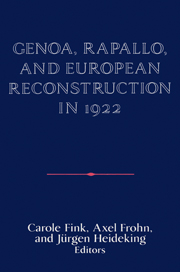Book contents
- Frontmatter
- Introduction
- 1 Beyond Revisionism: The Genoa Conference of 1922
- 2 The Genoa Conference of 1922: Lloyd George and the Politics of Recognition
- 3 A Rainy Day, April 16, 1922: The Rapallo Treaty and the Cloudy Perspective for German Foreign Policy
- 4 Reparations in 1922
- 5 Germany and the United States: The Concept of World Economic Interdependence
- 6 American Policy Toward Debts and Reconstruction at Genoa, 1922
- 7 French Plans for the Reconstruction of Russia: A History and Evaluation
- 8 The Oil Problem and Soviet-American Relations at the Genoa Conference of 1922
- 9 Italy at the Genoa Conference: Italian-Soviet Commercial Relations
- 10 The European Policy of Czechoslovakia on the Eve of the Genoa Conference of 1922
- 11 The Genoa Conference and the Little Entente
- 12 The Role of Switzerland and the Neutral States at the Genoa Conference
- 13 The Genoa Conference and Japan: A Lesson in Great-Power Diplomacy
- Maps
- Appendix
- Bibliography
- Contributors
- Index
3 - A Rainy Day, April 16, 1922: The Rapallo Treaty and the Cloudy Perspective for German Foreign Policy
Published online by Cambridge University Press: 05 January 2013
- Frontmatter
- Introduction
- 1 Beyond Revisionism: The Genoa Conference of 1922
- 2 The Genoa Conference of 1922: Lloyd George and the Politics of Recognition
- 3 A Rainy Day, April 16, 1922: The Rapallo Treaty and the Cloudy Perspective for German Foreign Policy
- 4 Reparations in 1922
- 5 Germany and the United States: The Concept of World Economic Interdependence
- 6 American Policy Toward Debts and Reconstruction at Genoa, 1922
- 7 French Plans for the Reconstruction of Russia: A History and Evaluation
- 8 The Oil Problem and Soviet-American Relations at the Genoa Conference of 1922
- 9 Italy at the Genoa Conference: Italian-Soviet Commercial Relations
- 10 The European Policy of Czechoslovakia on the Eve of the Genoa Conference of 1922
- 11 The Genoa Conference and the Little Entente
- 12 The Role of Switzerland and the Neutral States at the Genoa Conference
- 13 The Genoa Conference and Japan: A Lesson in Great-Power Diplomacy
- Maps
- Appendix
- Bibliography
- Contributors
- Index
Summary
Rapallo was by no means the dawn of a bright future for German foreign policy. The day when the widely discussed treaty between Soviet Russia and Germany was signed opened neither a new clear horizon nor a brilliant prospect for Germany's return to power. The German negotiators looked tense and exhausted, and immediately after the signing ceremonies, they had to explain, excuse, and defend what they had done.
Rapallo became the catchword for sudden, shocking, and spectacular, as well as dangerous, agreements and forms of cooperation between Germany and Russia. It also gave a modern expression to and confirmation of deeper and older fears active until today. In the famous Adams-Jefferson correspondence, after the German Wars of Liberation in the summer of 1814, John Adams was troubled by the gloomy prospects of Russo-German dominance of Europe. “What may happen?” he asked. “Could Wellingtons or Bonapartes resist them?” In May 1988, during the conflict over nuclear weapons in Europe, traditional fears and suspicions were rekindled, and distinguished American and British journalists discovered signs of a new form of German Drang nach Osten. These signs conjured up the calamity of German history because the West Germans once more seemed to shake the European order.
- Type
- Chapter
- Information
- Genoa, Rapallo, and European Reconstruction in 1922 , pp. 49 - 64Publisher: Cambridge University PressPrint publication year: 1991
- 1
- Cited by

